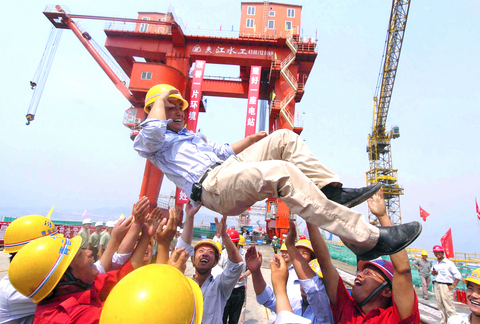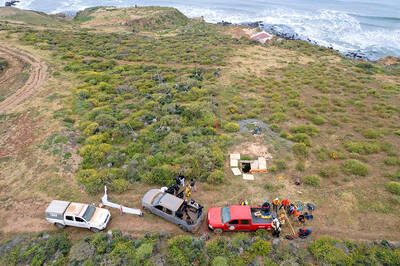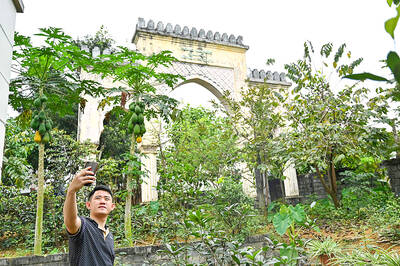After 13 years of immense physical effort and technical ingenuity, China yesterday put the finishing touches to its controversial Three Gorges dam, the world's largest hydropower project.
The official completion of the dam was marked by a short ceremony at the site broadcast live on state television, which touted it as an "important historic moment."
"I can announce to the Chinese people ... that the Three Gorges dam is completed," Li Yong'an, manager of the Three Gorges Construction Company, said shortly after the last load of cement was poured onto the top of the dam.

PHOTO: AP/XINHUA
The 2,309m-long, 185m-high block of concrete across the Yangtze is meant to control floods and generate electricity for a power-hungry nation, but for many Chinese it is about much more than that.
"The Three Gorges dam is excellent proof of what Chinese can accomplish," said Cao Guangjing, vice president of the China Yangtze Three Gorges Project Development Corporation. "This project will serve to inspire the Chinese people."
Although the final tonne of concrete has been poured, the immense structure will still not be fully operational for another two years.
The last generators need to be installed, and work still needs to be done on the ship lift that, together with a ship lock, will allow ocean-going vessels to navigate the vast reservoir that is filling up behind the dam.
Although it is not all over yet, many of the engineers felt it as if a page had been turned and a chapter in their personal lives was nearing conclusion.
"I started in 1993, fresh from university, and I have been here ever since," said engineer Wang Zilin, 43, from Zhejiang Province. "It's been my whole life. I even found my wife here."
Even while work was being carried out on the dam, engineers and laborers were reminded that flood control was one of the main reasons behind the giant project.
In 1998, a devastating flood on the Yangtze uprooted millions of families and killed more than 1,500 people. Two much larger disasters in the 1930s each claimed more than 140,000 lives.
Nevertheless, critics continue to argue that silt build-up and other problems mean the dam will fail to provide the hoped-for flood relief.
Opponents also see damage to the environment, ruin to China's heritage and misery to local residents forced from their homes for the project.
However, harnessing the power of China's mightiest rivers is a dream harbored by generations of Chinese.
In the early 20th century, Sun Yat-sen (
Mao Zedong (
It is no longer just the stuff of poetry. On the left bank, 14 sets of 700-megawatt turbine and generator units are already in operation.
On the right bank, another 12 700-megawatt units are under construction.
With a capacity already equivalent to Itaipu on the border of Brazil and Paraguay, which is now the world's largest operating hydroelectric dam, the Three Gorges will eventually overshadow all others.
A new tender process is due to be held by the end of the year for adding a new power station with another six 700-megawatt generators, underground on the right bank.
The dam will then become "the biggest in the world," according to the China Yangtze Three Gorges Project Corporation.
One final benefit touted for the project is that it will elevate the Yangtze for hundreds of kilometers inland, allowing ocean-going vessels to travel as far as Chongqing.
This will, planners hope, help open up China's underdeveloped west, which has in many ways missed out on economic reforms largely because of its isolation from overseas markets.
To ease upstream navigation, a ship lift will enable vessels of up to 3,000 tonnes to pass the dam in around 45 minutes, while a ship lock will do the same to 10,000-tonne vessels in two hours and 45 minutes.
With work on the dam complete, thousands of migrant workers will go home, many of them to Yunnan Province near the border with Vietnam, and to Qinghai Province near the Tibetan plateau.
But Wang was confident the dam's completion would not leave him unemployed.
"Every project takes at least 10 years, so I'll have more than enough work until I retire," he said.
"I've been lucky to work with something that I really love," he said.

With the midday sun blazing, an experimental orange and white F-16 fighter jet launched with a familiar roar that is a hallmark of US airpower, but the aerial combat that followed was unlike any other: This F-16 was controlled by artificial intelligence (AI), not a human pilot, and riding in the front seat was US Secretary of the Air Force Frank Kendall. AI marks one of the biggest advances in military aviation since the introduction of stealth in the early 1990s, and the US Air Force has aggressively leaned in. Even though the technology is not fully developed, the service is planning

INTERNATIONAL PROBE: Australian and US authorities were helping coordinate the investigation of the case, which follows the 2015 murder of Australian surfers in Mexico Three bodies were found in Mexico’s Baja California state, the FBI said on Friday, days after two Australians and an American went missing during a surfing trip in an area hit by cartel violence. Authorities used a pulley system to hoist what appeared to be lifeless bodies covered in mud from a shaft on a cliff high above the Pacific. “We confirm there were three individuals found deceased in Santo Tomas, Baja California,” a statement from the FBI’s office in San Diego, California, said without providing the identities of the victims. Australian brothers Jake and Callum Robinson and their American friend Jack Carter

Le Tuan Binh keeps his Moroccan soldier father’s tombstone at his village home north of Hanoi, a treasured reminder of a man whose community in Vietnam has been largely forgotten. Mzid Ben Ali, or “Mohammed” as Binh calls him, was one of tens of thousands of North Africans who served in the French army as it battled to maintain its colonial rule of Indochina. He fought for France against the Viet Minh independence movement in the 1950s, before leaving the military — as either a defector or a captive — and making a life for himself in Vietnam. “It’s very emotional for me,”

The Chinese Communist Party’s (CCP) Central Committee is to gather in July for a key meeting known as a plenum, the third since the body of elite decisionmakers was elected in 2022, focusing on reforms amid “challenges” at home and complexities broad. Plenums are important events on China’s political calendar that require the attendance of all of the Central Committee, comprising 205 members and 171 alternate members with Chinese President Xi Jinping (習近平) at the helm. The Central Committee typically holds seven plenums between party congresses, which are held once every five years. The current central committee members were elected at the